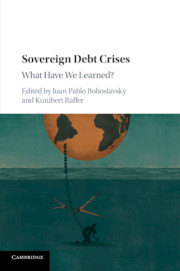Book contents
- Sovereign Debt Crises
- Sovereign Debt Crises
- Copyright page
- Dedication
- Contents
- Contributors
- 1 Introduction
- 2 Managing Public Debt Crisis in Argentina
- 3 Why Developing Countries Should Not Incur Foreign Debt
- 4 Ecuador’s 2008–2009 Debt Restructuring
- 5 Greece: An EU-Inflicted Catastrophe*
- 6 Grenada: A Small Island Developing State Needs New Ways Out of Its Debt
- 7 Iceland: A Human Rights-Sensitive Approach to Deal with Financial Crises
- 8 Indonesia’s 1997–1998 Economic Crisis
- 9 The Irish Sovereign Debt Crisis Post-2009
- 10 Short-Term Capital Controls and Malaysia’s Fast Recovery after the East-Asian Crisis
- 11 Sovereign Debt
- 12 Portugal’s Austerity Bailout
- 13 Don’t Waste a Serious Crisis*
- 14 Lessons from South Korea
- 15 The Spanish Crisis
- 16 Conclusions
- Index
4 - Ecuador’s 2008–2009 Debt Restructuring
A Special Case?
Published online by Cambridge University Press: 16 November 2017
- Sovereign Debt Crises
- Sovereign Debt Crises
- Copyright page
- Dedication
- Contents
- Contributors
- 1 Introduction
- 2 Managing Public Debt Crisis in Argentina
- 3 Why Developing Countries Should Not Incur Foreign Debt
- 4 Ecuador’s 2008–2009 Debt Restructuring
- 5 Greece: An EU-Inflicted Catastrophe*
- 6 Grenada: A Small Island Developing State Needs New Ways Out of Its Debt
- 7 Iceland: A Human Rights-Sensitive Approach to Deal with Financial Crises
- 8 Indonesia’s 1997–1998 Economic Crisis
- 9 The Irish Sovereign Debt Crisis Post-2009
- 10 Short-Term Capital Controls and Malaysia’s Fast Recovery after the East-Asian Crisis
- 11 Sovereign Debt
- 12 Portugal’s Austerity Bailout
- 13 Don’t Waste a Serious Crisis*
- 14 Lessons from South Korea
- 15 The Spanish Crisis
- 16 Conclusions
- Index
Summary
In late 2008, Ecuador launched a successful effort to restructure its external debt, the circumstances of which are unique in the recent history of sovereign debt restructurings. The country had a rocky history of debt repayment. In 1999, it became the first country to default on its Brady Bonds, which had been created to resolve the Latin American debt crisis of the 1980s. After debt restructurings in 1995 and 2000, the country had arguably sustainable levels of external debt. In 2006, Rafael Correa, running for president, promised to refuse to pay the country’s debt if elected. After he was elected, Correa formed a public debt audit commission to evaluate debt incurred by the country over the previous three decades. The commission found that some of the country’s bonds were illegitimate for various reasons, including unfair gains to private interests, oppressive terms in the bond contracts, and the fact that the country’s debt burden was crowding out provision of basic public goods and services. In late 2008, the country defaulted on two of its bond issues. After the default, and amid global financial turmoil, as the price of those bonds dropped, the country began a programme of purchasing them through financial intermediaries. It then conducted a bond repurchase at 35 cents on the dollar, with an eventual participation rate of over 90 per cent. This episode represents a rare instance of a sovereign restructuring external debt in the absence of acute financial stress and an equally rare instance of a sovereign having obtained debt relief based, at least in part, on the express assertion of the illegitimacy of its obligations. After a number of years without accessing capital markets, Ecuador agreed to repurchase most of its remaining defaulted debt from the 2008 episode and was able to issue bonds again in 2014. Because of various factors, including the unique global financial context and the country’s particular history of debt repayment, it is not clear whether one can draw any general lessons – regarding debt buy-backs or the viability of claims about legitimacy of debt, for example – from the 2008–09 episode.
- Type
- Chapter
- Information
- Sovereign Debt CrisesWhat Have We Learned?, pp. 48 - 64Publisher: Cambridge University PressPrint publication year: 2017
- 1
- Cited by



